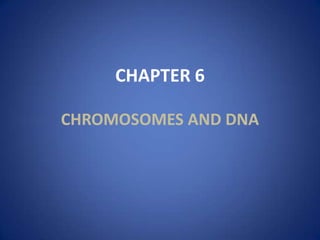
Gene expression
- 1. CHAPTER 6 CHROMOSOMES AND DNA
- 2. REPLICATION OF DNA Before the start of cell division, the DNA material in the original cell must be duplicated so that after cell division, each new cell contains the full amount of DNA material. The process of DNA duplication is usually called replication.
- 3. STRUCTURE OF DNA • DNA, or deoxyribonucleic acid, is the hereditary material in humans and almost all other organisms. Nearly every cell in a person’s body has the same DNA. Most DNA is located in the cell nucleus.
- 4. STRUCTURE OF NUCLEOTIDE • DNA is a double helix having two anti-parallel poly nucleotide chains whose basic unit is a nucleotide . • A Nucleotide consists of a nitrogenous base, pentose sugar, and a phosphate. • DNA contains four different types of nitrogenous bases, two with purine bases, adenine(A) and guanine (G) which have a double ring, and two with pyrimidine bases, thymine (T) and cytosine (C) which have a single ring.
- 6. MODELS OF DNA REPLICATION There are three models of DNA replication. Semi Conservative conservative model model Dispersive model
- 7. REPLICATION OF DNA • DNA replication requires the concerted action of a number of proteins. • The proteins involved are clustered together in the cell. • The DNA to be copied is fed through the proteins of the replication factory. • The duplex DNA to be copied is unzipped into single strand. • Each of the two template strand is copied and becomes half of a new DNA double helix. • DNA replication is semi conservative.
- 8. REPLICATION OF DNA Steps of DNA replication Formation of replication fork (unzipping) Ligation of Formation of okazaki RNA primer fragments Formation of Removal of new DNA RNA primer strands
- 9. REPLICATION OF DNA • Helicase Enzymes • Single strand binding proteins • Primase Of • DNA polymerase III • DNA polymerase I Replication • DNA ligase
- 11. GENE EXPRESSION
- 13. TRANSCRIPTION • The production of mRNA from DNA is called Transcription. • There are three types of RNA 1. Ribosomal RNA (r RNA) 2. Transfer RNA (t RNA) 3. Messenger RNA (m RNA)
- 14. MESSENGER RNA • It is formed from DNA inside the nucleus. • It carries the coded information (codons) from DNA to ribosomes in the cytoplasm to be translated into protein.
- 15. TRANSFER RNA • It is present in cytoplasm and consists of two ends and a central loop portion. • The loop has specific base sequence called Anticodon which is the site of attachment to m RNA. • There are more than 40 different kinds of t RNA. • Each t RNA picks up specific amino acid at its one end according to its anticodon and transfer it to ribosomes during protein synthesis.
- 16. RIBOSOMAL RNA • It is found in ribosomes. • It provides site for lining up the amino acids in the sequence dictated by m RNA fop the formation of polypeptide chain.
- 17. PROCESS OF TRANSCRIPTION • Transcription is initiated when a special enzyme called RNA Polymerase binds to a particular sequence of nucleotides on one of the DNA strand which is present at the edge of a gene. • The RNA Polymerase proceed to assemble a single strand of RNA with a nucleotide sequence complementary to the DNA strand it has bound. • Assembly of bases occur according to base pairing rules i.e. • Adenine to Uracil • Thymine to Adenine • Cytosine to Guanine • Guanine to Cytosine
- 18. TRANSLATION • The process of m RNA directed poly peptide synthesis by ribosomes is called Translation. • Translation begins when a newly formed and processed m RNA enters the cytoplasm via nuclear pore, where many free amino acids, t RNA and ribosomes are present. • Translation proceeds in three steps: 1. Initiation 2. Elongation 3. Termination
- 19. PROCESS OF TRANSLATION Initiation A t RNA binds to the one end of m RNA transcript having start codon i.e. AUG Elongation Amino acids brought by t RNA assemble according to the sequence of codons on m RNA which is passing between two ribosomal subunits. Termination It occurs when stop codon comes on m RNA (UAA,UAG,UGA) and newly formed polypeptide chain is released from ribosome.
- 20. GENETIC CODE • The information present in the sequence of nucleotides on DNA carried by RNA for the synthesis of proteins is called genetic code. • A series of three adjacent bases in DNA or RNA which codes for a specific amino acid is called codon or triplet code. • The m RNA codons are recognized by t RNA having anticodons, carrying a particular amino acid and binding to m RNA. This is called Decoding.
- 21. CODONS OF m RNA
